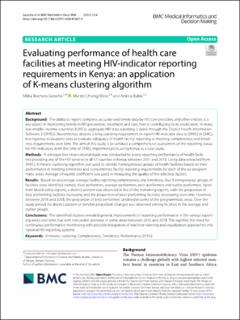| dc.description.abstract | Background: The ability to report complete, accurate and timely data by HIV care providers and other entities is a key aspect in monitoring trends in HIV prevention, treatment and care, hence contributing to its eradication. In many low-middle-income-countries (LMICs), aggregate HIV data reporting is done through the District Health Information Software 2 (DHIS2). Nevertheless, despite a long-standing requirement to report HIV-indicator data to DHIS2 in LMICs, few rigorous evaluations exist to evaluate adequacy of health facility reporting at meeting completeness and timeliness requirements over time. The aim of this study is to conduct a comprehensive assessment of the reporting status for HIV-indicators, from the time of DHIS2 implementation, using Kenya as a case study.
Methods: A retrospective observational study was conducted to assess reporting performance of health facilities providing any of the HIV services in all 47 counties in Kenya between 2011 and 2018. Using data extracted from DHIS2, K-means clustering algorithm was used to identify homogeneous groups of health facilities based on their performance in meeting timeliness and completeness facility reporting requirements for each of the six programmatic areas. Average silhouette coefficient was used in measuring the quality of the selected clusters.
Results: Based on percentage average facility reporting completeness and timeliness, four homogeneous groups of facilities were identified namely: best performers, average performers, poor performers and outlier performers. Apart from blood safety reports, a distinct pattern was observed in five of the remaining reports, with the proportion of best performing facilities increasing and the proportion of poor performing facilities decreasing over time. However, between 2016 and 2018, the proportion of best performers declined in some of the programmatic areas. Over the study period, no distinct pattern or trend in proportion changes was observed among facilities in the average and outlier groups.
Conclusions: The identified clusters revealed general improvements in reporting performance in the various reporting areas over time, but with noticeable decrease in some areas between 2016 and 2018. This signifies the need for continuous performance monitoring with possible integration of machine learning and visualization approaches into national HIV reporting systems. | en_US |

